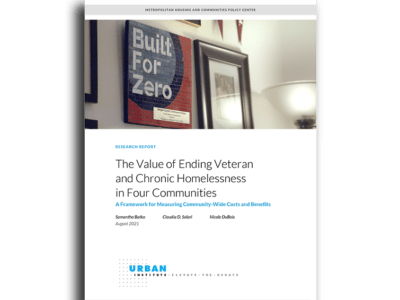Homelessness is often considered an urban phenomenon. While people experiencing homelessness predominantly reside in urban areas, rural areas have recently seen an uptick in their unsheltered homeless populations and housing instability. Within these rural areas, the local planning bodies responsible for coordinating the full range of homeless services are called Continuums of Care.
From 2021 to 2022, rural Continuums of Care saw a 27% increase in homelessness. In fact, while the number of people experiencing homelessness in the United States rose by less than 1% from 2020 to 2022, rural communities saw an overall increase of nearly 6%, according to the Point-in-Time (PIT) count.
Experts attribute this acute increase in homelessness in rural areas to higher, more persistent levels of poverty and lower incomes. Rural communities also often struggle to provide decent, accessible, and affordable rental homes. In addition to those experiencing homelessness, far too many rural renters live in unaffordable, overcrowded, or substandard homes.
This post examines the escalating issue of homelessness in rural areas, investigating factors contributing to this rise, such as lack of affordable housing and poverty. It also highlights Community Solutions’ policy recommendations for addressing these systemic issues on a federal level.
Preservation of affordable housing in rural areas
According to the National Low Income Housing Coalition, nearly $5.6 billion is needed over the next 20 years to preserve the more than 470,000 rental homes within USDA’s portfolio for current and future residents. This essential community infrastructure constitutes the main source of affordable rental housing in rural communities. This issue needs to be addressed; the longer investment is delayed, the more expensive it will be to preserve these homes.
Eighty-seven percent of U.S. counties have at least one USDA Section 515 property. USDA’s Section 515 Rural Rental Housing Loan Program provides mortgage loans to develop rental housing for very low, low-, and moderate-income households. Individuals, partnerships, corporations (for-profit and nonprofit), limited equity cooperatives, Native American tribes, and public agencies can apply as eligible owners for Section 515-financed housing. While Section 515 was once a principal driver of affordable housing production in rural areas, no new construction under the program has taken place since 2012. Section 515 has funded the production of over 530,000 units since its inception. In 1984, Congress appropriated $919 million for the Section 515 program; in fiscal year 2023, that amount dwindled to $70 million, a reduction of almost 95%.
USDA estimates that rural communities will lose nearly 1,800 rental homes annually due to maturing mortgages between 2016 and 2027, more than 16,000 rental homes annually between 2028 and 2032, and 22,000 homes annually in the following years. When these loans reach maturity, property owners are no longer required to meet affordability standards and may convert their properties to market-rate housing or cease operation altogether. Furthermore, once the USDA loan on their home matures, low-income tenants are no longer eligible for USDA rural rental assistance. With the average annual income of Section 515 tenants at $13,640, the maturing of these loans increases the risk of rent burden, eviction, and homelessness for rural families.
Recommendations
- Congress should decouple Section 521 Rural Rental Assistance from the requirement that a property must have a USDA mortgage to receive assistance.
- Congress should allow low-income tenants to continue to receive rental assistance after the property’s Section 515 mortgage matures.
- Congress should significantly expand investments in Section 515 and the Multifamily Housing Preservation and Revitalization Program (MPR) to preserve affordable homes in rural America, as well as permanently authorize MPR.
Supply of deeply affordable housing in rural areas
Rural communities encounter unique challenges in creating affordable rental homes due to lower incomes, higher poverty rates, and limited access to private funding. Consequently, many rural families end up living in unaffordable or substandard rental properties. This shortage occurs because the private sector cannot construct or operate homes that are affordable for extremely low-income households without subsidies from the government.
The fact that rural communities are not currently designated as “Difficult to Develop Areas” (DDAs) compounds this issue. This official designation acknowledges the struggles of an area in attracting investment and development due to factors such as economic disadvantages, limited infrastructure, geographic remoteness, and other barriers. Moreover, it provides increased tax incentives for affordable housing development in designated areas.
Similarly, rural communities would benefit from increased access to the USDA’s Community Facilities Guaranteed Loan Program. This loan program provides grants, loans, and loan guarantees to construct, expand, or rehabilitate community facilities such as hospitals, clinics, nursing homes, care centers, police and fire stations, communication centers, schools, and more. Despite the program’s aim to support essential community facility development in rural areas, eligible lenders in these regions have not taken full advantage of the provided loan guarantees. These guarantees are intended to assist in the orderly development of rural communities, encompassing cities, towns, counties, or multi-county areas, by funding nonprofit public improvements that serve rural residents and businesses.
Recommendations:
- To address housing needs in rural America, Congress should include in any tax extenders package a change to designate rural communities as “DDAs,” making housing developments in rural America automatically eligible for a 30% basis boost.
- Ensure that USDA funding can be easily combined with other funding sources for affordable housing development and preservation, especially the Housing Credit and state and local sources.
- USDA should explicitly permit the Community Facilities Guaranteed Loan program to finance workforce housing in rural communities.
- USDA should encourage and facilitate nonprofits to include dormitory-style rooms and assisted living programs using the Community Facilities Guaranteed Loan program to increase the range of housing-related options in rural communities.
Data on rural homelessness
Most data on homelessness in the United States is based on Point-in-Time (PIT) counts. Every year, communities that receive federal funding for homelessness conduct this annual count of people experiencing homelessness on a single night. The PIT count is meant to serve as a snapshot of homelessness in a community and to provide a sense of the overall scope of homelessness in America.
This means that local agencies and volunteers must conduct a survey to estimate the number of people experiencing homelessness in their communities during the last ten days in January when the weather turns cold and people are most likely to seek shelter.
Because of vast rural spaces, the fact that many individuals and families live in substandard housing or are doubled up, and the lack of shelter systems mean that these surveys are largely inaccurate in rural areas. Yet these point-in-time counts determine how federal funding from multiple agencies is allotted to communities to the extreme disadvantage of rural counties.
The Biden-Harris administration’s All In: The Federal Strategic Plan to Prevent and End Homelessness set a bold goal to reduce homelessness by 25% by 2025 through a variety of public policy strategies. Measuring progress towards this goal will require accurate, up-to-date information on every person experiencing homelessness and provisions to be made to enable accurate data collection in rural communities.
Recommendation:
- Communities have found that accurate, person-specific, comprehensive, and timely data is critical for equitably reducing homelessness. Rural communities should be resourced to collect quality, by-name, comprehensive data on a monthly basis on every individual and family experiencing homelessness within their geographies, and to maintain accurate information in well-supported Homelessness Management Information System databases.
Conclusion
Addressing rural homelessness requires a comprehensive approach that focuses on preserving affordable housing, increasing the supply of deeply affordable housing, and improving data collection and use to guide resource allocation and measure progress toward ending homelessness in each community. The rise in homelessness in rural areas underscores the urgency of implementing policies that ensure housing stability.
For more information, contact Chan Kemper, Manager of Federal Policy at Community Solutions, at ckemper@community.solutions.




